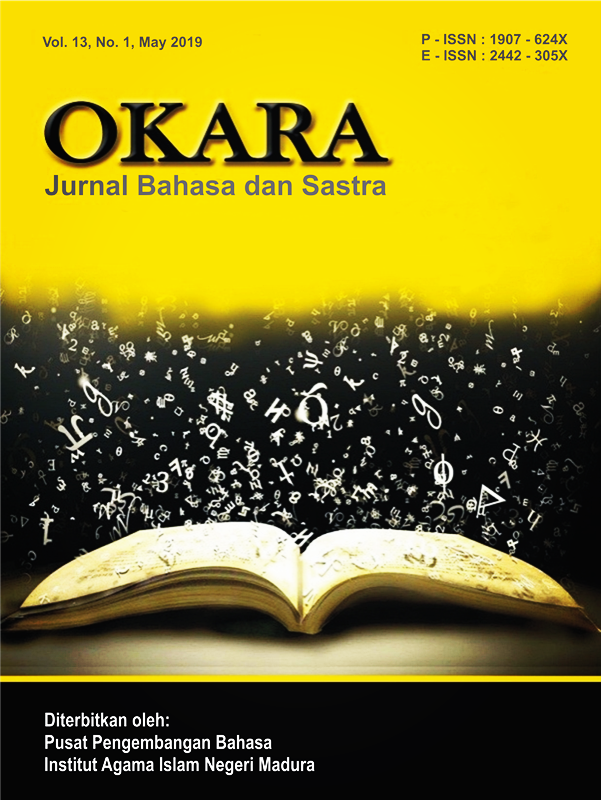Phonological Disorders of Children with Down Syndrome Based on the Level of Intelligence: A Case Study
 Abstract views: 382
,
Abstract views: 382
,
 PDF downloads: 283
PDF downloads: 283
Abstract
Many of speech therapists have given therapy to the children with Down Syndrome (DS) without thinking whether the children belong to mild mental retardation (IQ 50-69) or moderate mental retardation DS children (IQ 35-49). Therefore, a study was conducted to see the differences and the findings showed that the moderate mental retardation DS child dominated the three types of phonological disorders, i.e. phoneme substitution, simplification, and addition. In this research, the last type of phonological disorder was not found for both DS children. In addition, the mild mental retardation DS child responded the stimulus, yet the moderate mental retardation DS child could not answer about 1/5 stimulus given. It was also found that the moderate mental retardation DS child was so sensitive with touching. So, the therapy for the DS should not be the same. For the mild mental retardation DS children (IQ 5-069), the stimulus given to them could be by using flash cards, but for the moderate mental retardation down syndrome children (IQ 35-49), the stimulus should be something real, concrete, or something that could be touched so that they can respond the stimulus well and their language can be better in the future.
Downloads
References
Baihaqi, M Luthfi. ‘Kompetensi Fonologis Anak Penyandang Down Syndrome di SLB C Negeri 1 Yogyakarta’. Widyariset Pusbindiklat LIPI 14, no. 1 (2011): 153–62. https://doi.org/10.14203/ widyariset.14.1.2011.153-162.
Blumstein, Sheila E. A Phonological Investigation of Aphasic Speech. The Haque: Mouton, 1973.
Brock, Jon, and Christopher Jarrold. ‘Language Influences on Verbal Short-Term Memory Performance in Down Syndrome: Item and Order Recognition’. Journal of Speech, Language, and Hearing Research 47, no. 6 (December 2004): 1334–46. https://doi.org/10.1044/1092-4388(2004/100).
Caselli, Maria Cristina, Laura Monaco, Manuela Trasciani, and Stefano Vicari. ‘Language in Italian Children with Down Syndrome and with Specific Language Impairment.’ Neuropsychology 22, no. 1 (2008): 27–35. https://doi.org/10.1037/0894-4105.22.1.27.
Dodd, B., and L. Thompson. ‘Speech Disorder in Children with Down’s Syndrome’. Journal of Intellectual Disability Research 45, no. 4 (August 2001): 308–16. https://doi.org/10.1046/j.1365-2788.2001.00327.x.
Elisabeth, Ahlsen. Introduction to Neurolinguistics. Amsterdam: John Benjamins Publishing Company, 2006.
Ester, Monica. Terapi Wicara Untuk Praktisi Pendidikan Dan Kesehatan. Jakarta: Penerbit Buku Kedokteran, 2000.
Ingram, John C. L. Neurolingusitics: An Introduction to Spoken Language Processing and Its Disorders. Cambridge: Cambridge University Press, 2007.
Mastoyo, Tri. Pengantar (Metode) Penelitian Bahasa. Yogyakarta: Caracvatibooks, 2007.
Perovic, Alexandra. ‘Syntactic Deficit in Down Syndrome: More Evidence for the Modular Organisation of Language’. Lingua 116, no. 10 (October 2006): 1616–30. https://doi.org/10.1016/j.lingua.2005.05.011.
Prasher, Vee P. Neuropsychological Assessment of Dimentia in Down Syndrome and Intellectual Disabilities. London: Springer, 2009.
Purnanto, Sumarlam Dwi, and Sri Pamungkas. ‘Karakterstik Bahasa Anak-Anak Down Syndrome Di Kampung Down Syndrome Kabupaten Ponorogo (Suatu Tinjauan Psikolinguistik)’, 2014.
Sardanto, Rino. ‘A Study of Error on English Speech Used by the Radio Announcer at Brass FM Kediri’. OKARA: Jurnal Bahasa Dan Sastra 1, no. 1 (2014): 12. https://doi.org/10.19105/ojbs.v8i1.454.
Stemmer, Brigitte, and Harry A. Whitaker. Handbook of Neurolinguistics. California: Academic Press, 1998.
Utami, Agustina Ridho, and Noor Malihah. ‘Speech Errors Produced by EFL Learners of Islamic Boarding School in Telling English Story’. OKARA: Jurnal Bahasa Dan Sastra 12, no. 2 (30 November 2018): 191. https://doi.org/10.19105/ojbs.v12i2.1930.
Zimpel, Andre Frank. Trisomi 21: What Can We Learn from People with Down Syndrome. Bristol: Vandenhoeck & Ruprecht GmbH & Co. KG, Gottingen, 2016.
The journal operates an Open Access policy under a Creative Commons Attribution-NonCommercial 4.0 International License. Authors who publish with this journal agree to the following terms:
- Authors retain copyright and grant the journal right of first publication with the work simultaneously licensed under a Creative Commons Attribution License that allows others to share the work with an acknowledgement of the work's authorship and initial publication in this journal.
- Authors are able to enter into separate, additional contractual arrangements for the non-exclusive distribution of the journal's published version of the work (e.g., post it to an institutional repository or publish it in a book), with an acknowledgement of its initial publication in this journal.
- Authors are permitted and encouraged to post their work online (e.g., in institutional repositories or on their website) prior to and during the submission process, as it can lead to productive exchanges, as well as earlier and greater citation of published work.





_(1).png)
.png)
.png)
1.png)
.png)
.png)

.png)
_-_Copy_-_Copy.png)





